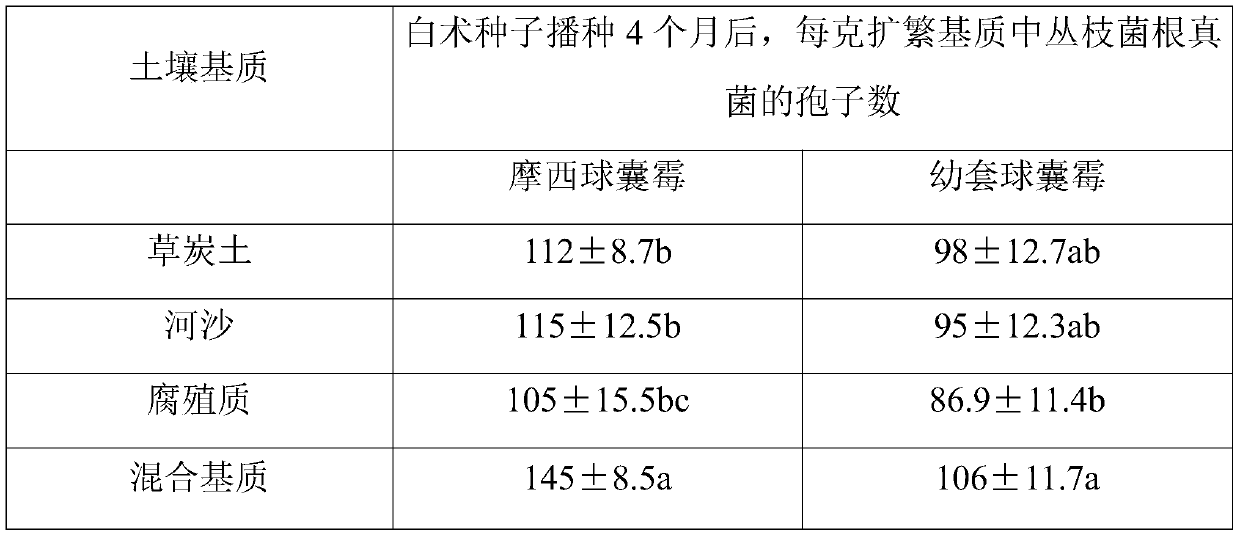A method for improving the growth and drought resistance of Atractylodes macrocephala seedlings
An Atractylodes Rhizoma Atractylodes Rhizoma technology, applied in the field of treatment of Atractylodes Rhizoma seedlings, can solve the problems of weakened resistance, high seedling mortality, and quality decline, and achieves the effect of overcoming weakened resistance, strong drought resistance, and expanding development.
- Summary
- Abstract
- Description
- Claims
- Application Information
AI Technical Summary
Problems solved by technology
Method used
Image
Examples
Embodiment 1
[0034] Embodiment 1: the selection of the propagation substrate of arbuscular mycorrhizal fungus
[0035] In order to select the best substrate for the propagation of arbuscular mycorrhizal fungi, the present embodiment 1 uses peat soil, river sand, humus and mixed substrates (peat soil, river sand, and humus are mixed in a volume ratio of 2:2:1). Four kinds of propagation substrates for the first strain "Glomus moses" and the second strain "Globus moses" are put into the autoclave after passing through a 20-mesh sieve. Sterilize at 121°C for 20 minutes to completely kill the arbuscular mycorrhizal fungi in the propagation substrates, and dry the sterilized four propagation substrates for later use.
[0036] The expansion of arbuscular mycorrhizal fungi includes the expansion of the first arbuscular mycorrhizal fungi and the expansion of the second arbuscular mycorrhizal fungi; a: the expansion of the first arbuscular mycorrhizal fungi
[0037]①Use Glomus mosei as the first b...
Embodiment 2
[0050] Example 2: Selection of Host Plants for the Propagation of Glomus mosei and Glomus juniperus
[0051] Glomus mosesi and Glomus juveniles are both arbuscular mycorrhizal fungi that need to live in symbiosis with plant roots, so choosing a suitable host plant is crucial for the proliferation of Glomus moses and Glomus juveniles. White clover and wheat were selected as hosts, Glomus mosseae and Glomus ovata were selected as strains, and a mixed substrate (peat soil, river sand, and humus in a volume ratio of 2:2:1 was selected) Mixed) as the propagation substrate of Glomus moses and Glomus juveniles, a total of 6 pots are needed, three pots adopt Glomus moses, and the other three pots use Glomus juveniles, and 20g strains are put in each pot of 3kg substrate (Glomus mosesi or Glomus juniperis), sterilized white clover and wheat seeds with 10% hydrogen peroxide for 15 minutes, sowed white clover and wheat alone, and mixed planting of white clover and wheat at a ratio of 1:1...
Embodiment 3
[0059] Embodiment 3: the influence of different cerium chloride concentrations on the germination of Atractylodes macrocephala seeds
[0060] Select plump Atractylodes macrocephala seeds, prepare 1, 3, 6, 9, and 12mmol / L cerium chloride solutions respectively, soak the Atractylodes macrocephala seeds in different concentrations of cerium chloride solutions for 2 hours, and then rinse the Atractylodes macrocephala seeds twice with clean water for backup use. Choose loose sandy conglomerate soil with good air permeability as the Atractylodes macrocephala seedling substrate, and add 50-100g of decomposed dried chicken manure to each pot. Mix the same amount of saccharomyces strains, sprinkle them evenly in the flowerpots, 30-50g per pot, then fill the flowerpots with the Atractylodes macrocephala seedling substrate, and finally sprinkle the Atractylodes macrocephala seeds soaked in the rare earth solution on the surface of the substrate, and use a little Atractylodes macrocephala...
PUM
 Login to View More
Login to View More Abstract
Description
Claims
Application Information
 Login to View More
Login to View More - R&D
- Intellectual Property
- Life Sciences
- Materials
- Tech Scout
- Unparalleled Data Quality
- Higher Quality Content
- 60% Fewer Hallucinations
Browse by: Latest US Patents, China's latest patents, Technical Efficacy Thesaurus, Application Domain, Technology Topic, Popular Technical Reports.
© 2025 PatSnap. All rights reserved.Legal|Privacy policy|Modern Slavery Act Transparency Statement|Sitemap|About US| Contact US: help@patsnap.com



